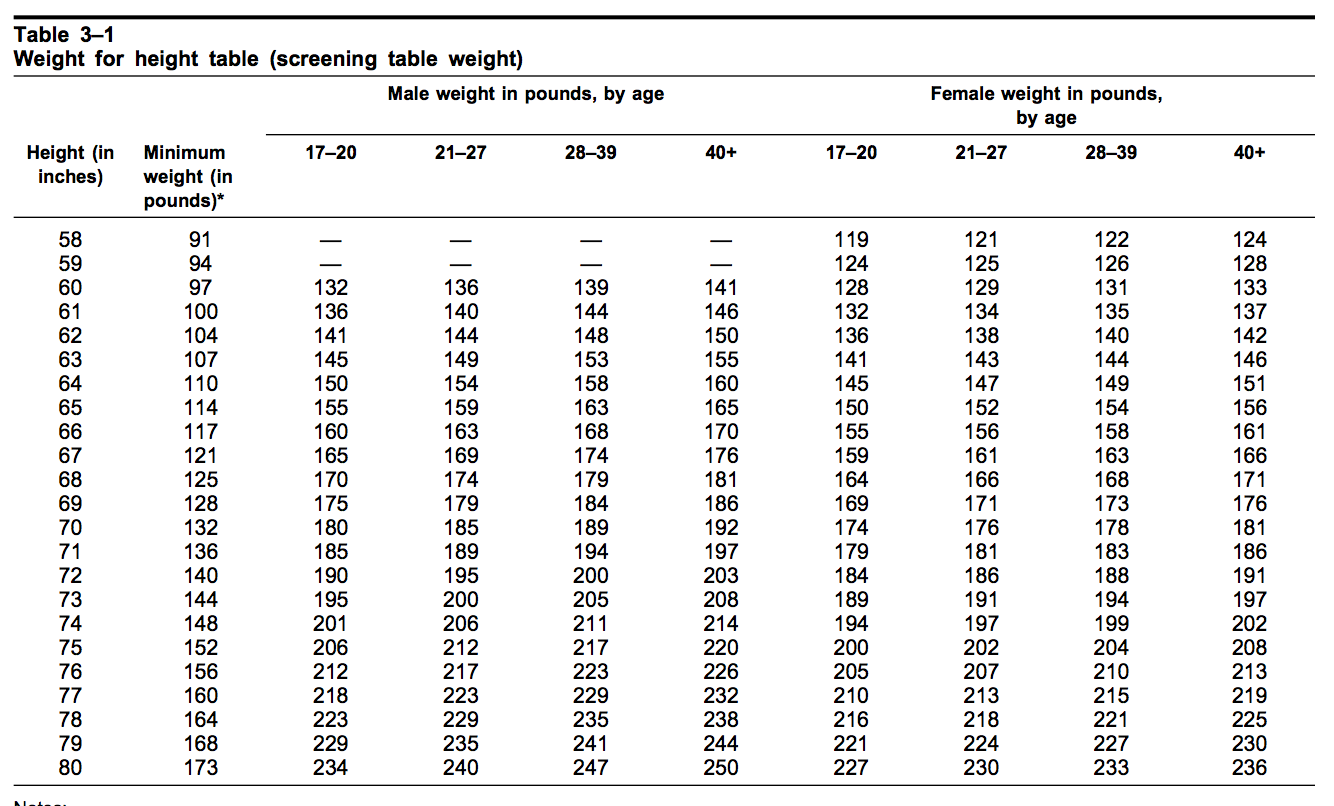The Army height and weight standards are crucial parameters that ensure all soldiers maintain a level of fitness and readiness. These standards are not only important for the individual soldier's health but also for the overall effectiveness of the military unit. In this article, we will delve into the specifics of army height and weight requirements, explore their significance, and provide insights on how soldiers can meet these standards.
Maintaining an optimal height and weight ratio is essential for soldiers not just for appearance, but for performance in the field. The Army has established guidelines that help determine whether a soldier is within the acceptable limits. These standards are based on various factors, including age, gender, and body composition. Understanding these guidelines is vital for current and prospective soldiers alike.
Furthermore, the implications of failing to meet height and weight standards can be significant, affecting a soldier's career progression and opportunities for advancement. Therefore, it is imperative to grasp the requirements and take appropriate actions to comply with them. In this detailed article, we will discuss the army's standards, the testing methods, and strategies for achieving and maintaining the required fitness levels.
Table of Contents
- 1. Overview of Army Height and Weight Standards
- 2. Importance of Maintaining Standards
- 3. Height and Weight Tables
- 4. Body Composition and its Significance
- 5. Consequences of Not Meeting Standards
- 6. Strategies for Compliance
- 7. Frequently Asked Questions
- 8. Conclusion and Call to Action
1. Overview of Army Height and Weight Standards
The U.S. Army has set specific height and weight requirements to ensure that all soldiers are physically capable of performing their duties. These standards are detailed in Army Regulation 600-9. The height and weight measurements are taken to assess the body composition of soldiers and to ensure they meet the necessary requirements.
1.1 Height Requirements
Height requirements vary based on gender and age. Generally, male soldiers must be between 60 to 80 inches, while female soldiers should be between 58 to 80 inches. These measurements are taken in a standing position without shoes.
1.2 Weight Requirements
Weight standards are determined using the Army height and weight tables. Each soldier's weight must fall within the prescribed limits for their height. These limits are designed to promote health and physical readiness.
2. Importance of Maintaining Standards
Maintaining height and weight standards is critical for several reasons:
- Operational Readiness: Soldiers must be fit to perform their duties effectively.
- Health and Safety: Excess body fat can lead to health issues that may impair performance.
- Career Advancement: Failing to meet standards can hinder a soldier's career progression.
3. Height and Weight Tables
The Army provides specific height and weight tables that outline the maximum allowable weight for each height category. These tables are available in the Army Regulation 600-9.
Here’s a simplified example:
| Height (inches) | Maximum Weight (lbs) |
|---|---|
| 60 | 140 |
| 70 | 190 |
| 80 | 250 |
4. Body Composition and its Significance
Body composition is a crucial aspect of the Army’s assessment of soldier fitness. The Army uses body fat percentage as a key indicator of health.
4.1 Assessment Methods
The Army employs various methods to assess body composition, including:
- Waist circumference measurements
- Body fat calipers
- Bioelectrical impedance analysis
4.2 Importance of Body Composition
Maintaining an appropriate body composition is essential for effective military performance and overall health. It helps prevent injuries and enhances physical capabilities.
5. Consequences of Not Meeting Standards
Soldiers who fail to meet the height and weight standards may face serious consequences, including:
- Non-judicial punishment
- Reduction in rank
- Ineligibility for promotion
6. Strategies for Compliance
To meet the Army's height and weight standards, soldiers can adopt several strategies:
- Regular Exercise: Incorporate aerobic and strength training exercises.
- Healthy Eating: Maintain a balanced diet rich in nutrients.
- Hydration: Stay well-hydrated to support overall health.
7. Frequently Asked Questions
Here are some common questions regarding the Army height and weight standards:
7.1 What happens if I don't meet the standards?
Failing to meet the standards can lead to disciplinary actions, including extra training and possible administrative action.
7.2 Are there exemptions to the height and weight standards?
Yes, there are exemptions for certain medical conditions, but they require proper documentation and approval.
8. Conclusion and Call to Action
Understanding and adhering to the Army height and weight standards is crucial for maintaining operational readiness and personal health. Soldiers must take proactive steps to meet these standards to ensure their success in the military. If you have questions or need support in achieving your fitness goals, consider reaching out to a fitness professional or your chain of command.
We encourage you to leave comments below, share this article with fellow soldiers, and explore our other resources to stay informed and prepared!
You Might Also Like
Discover The Beauty Of Kelly Moore Colors: A Comprehensive GuideDistance From New York City To London: A Comprehensive Guide
Exploring Rick Ness's Girlfriend: A Deep Dive Into Their Relationship
Hugh Hefner Costumes: Embrace The Iconic Style Of A Legend
Keegan Michael Key Age: A Comprehensive Overview Of His Life And Career
Article Recommendations


